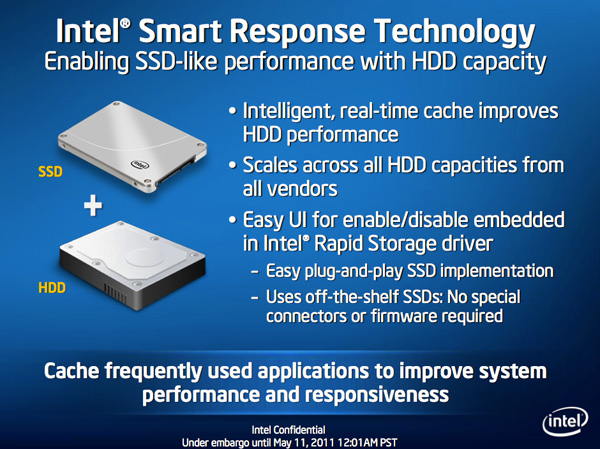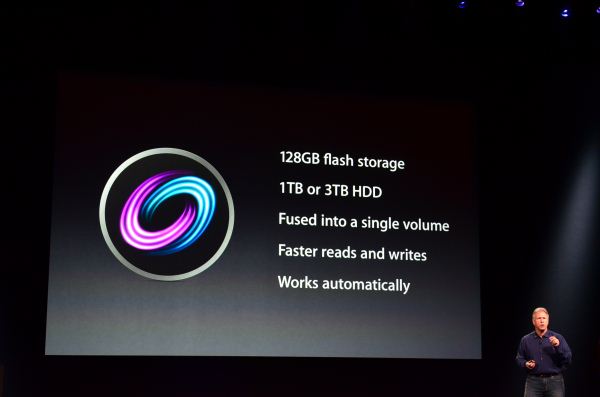A Month with Apple's Fusion Drive
by Anand Lal Shimpi on January 18, 2013 9:30 AM EST- Posted in
- Storage
- Mac
- SSDs
- Apple
- SSD Caching
- Fusion Drive
When decent, somewhat affordable, client focused solid state drives first came on the scene in 2008 the technology was magical. I called the original X25-M the best upgrade you could do for your system (admittedly I threw in the caveat that I’d like to see > 100GB and at a better price than $600). Although NAND and SSD pricing have both matured handsomely over time, there’s still the fact that mechanical storage is an order of magnitude cheaper.
The solution I’ve always advocated was a manual combination of SSD and HDD technologies. Buy a big enough SSD to house your OS, applications and maybe even a game or two, and put everything else on a RAID-1 array of hard drives. This approach works quite well in a desktop, but you have to be ok with manually managing where your files go.
I was always curious about how OEMs would handle this problem, since educating the masses on having to only put large, infrequently used files on one drive with everything else on another didn’t seem like a good idea. With its 6-series chipsets Intel introduced its Smart Response Technology, along with a special 20GB SLC SSD designed to act as a cache for a single hard drive or a bunch in an array.

Since then we’ve seen other SSD caching solutions come forward that didn’t have Intel’s chipset requirements. However most of these solutions were paired with really cheap, really small and really bad mSATA SSDs. More recently, OEMs have been partnering with SSD caching vendors to barely meet the minimum requirements for Ultrabook certification. In general, the experience is pretty bad.
Hard drive makers are working on the same problem, but are trying to fix it by adding a (very) small amount of NAND onto their mechanical drives. Once again this usually results in a faster hard drive experience, rather than an approximation of the SSD experience.
Typically this is the way to deal with hiding latency the lower you get in the memory hierarchy. Toss a small amount of faster memory between two levels and call it a day. Unlike adding a level 3 cache to a CPU however, NAND storage devices already exist in sizes large enough to house all of your data. It’s the equivalent of having to stick with an 8MB L3 cache when for a few hundred dollars more you could have 16GB. Once you’ve tasted the latter, the former seems like a pointless compromise.
Apple was among the first OEMs to realize the futility of the tradeoff. All of its mainstream mobile devices are NAND-only (iPhone, iPad and MacBook Air). More recently, Apple started migrating even its professional notebooks over to an SSD-only setup (MacBook Pro with Retina Display). Apple does have the luxury of not competing at lower price points for its Macs, which definitely makes dropping hard drives an easier thing to accomplish. Even so, out of the 6 distinct Macs that Apple ships today (MBA, rMBP, MBP, Mac mini, iMac and Mac Pro), only two of them ship without any hard drive option by default. The rest come with good old fashioned mechanical storage.
Moving something like the iMac to a solid state configuration is a bit tougher to pull off. While notebook users (especially anyone using an ultraportable) are already used to not having multiple terabytes of storage at their disposal, someone replacing a desktop isn’t necessarily well suited for the same.

Apple’s solution to the problem is, at a high level, no different than all of the PC OEMs who have tried hybrid SSD/HDD solutions in the past. The difference is in the size of the SSD component of the solution, and the software layer.










127 Comments
View All Comments
philipma1957 - Friday, January 18, 2013 - link
I purchased a mid range mini a Qaud 2.3 with just a 1tb hdd. I added a samsung 830 512gb ssd as the second drive. If you put the ssd in with no format and boot with an external drive you then go to disk utility the internal ssd and internal hdd are highlighted in red. The disk utility sees it as a broken fusion answer yes to fix it and in under a minute you have a 1.5tb fusion. then do an internet recovery to load mountain lion and you have a standalone mac mini with a killer 1.5tb fusion. Everything you mention in your tests(about the ssd being taxed) is less true basically because the ssd is huge and in a 1 to 2 ratio with the hdd. This is the closest I have come to a 1.5 tb ssd.I copied a 500gb eyetv folder with 30 18gb recordings easy peasy. So if you have a 2012 or even a 2011 mac mini and mountain lion just add a big ssd and fusion away.
hypopraxia - Friday, January 18, 2013 - link
I am with you on this one. Fusion drive with a higher SSD to HDD ratio nets huge gains in snappiness and overall SSD-ness of the fusion drive. I have only encountered IO slowdown once or maybe twice in the 2 months I've been running with Fusion.Munkyman42 - Tuesday, March 5, 2013 - link
eeep!I wonder if this'll work on my 2010 Mac Mini Server. If I can squeeze another year or two or performance with even a 64GB SSD upgrade my wallet would be thrilled!
Mr_SkoT_A - Tuesday, May 14, 2013 - link
I have done it on a late 2008 Unibody Macbook and an original Mini Server. Works like a charm!Hughmungalous - Friday, August 30, 2013 - link
I DID IT on a late 2008 macbbok ;-P 250GB Samsung 840 with a WD Blue 640GB HDD its been in a fusion for about 3 months now and runs beautifully... its basically a media server for me and my wife and it never slacks on its duties!!! its snappy switching profiles and logging in and out... wifey uses safari and flash games and what not and i never hear her complain anymore about her slack windows computer... i use it for heavy downloading light gaming and media server. Mr_SkoT_A Just installed i did the fusion setup which was fairly easy, except i used a specific number and got a 860GB drive instead of using a "100%" value to create the (correct amount) 890GB drive so i have 30GB of my drive in fusion limbo right now... all in all i love it the samsung drive was a smart buy i would love to hear from someone who runs with like a 60gb SSD and a 1TB HDD would be nice to know how much money i could have savedNans - Tuesday, December 30, 2014 - link
Did you fusion drive, from recovery Disk Utility as "I purchased a mid range mini a Qaud 2.3 with just a 1tb hdd. I added a samsung 830 512gb ssd as the second drive. If you put the ssd in with no format and boot with an external drive you then go to disk utility the internal ssd and internal hdd are highlighted in red. The disk utility sees it as a broken fusion answer yes to fix it and in under a minute you have a 1.5tb fusion. then do an internet recovery to load mountain lion and you have a standalone mac mini with a killer 1.5tb fusion. Everything you mention in your tests(about the ssd being taxed) is less true basically because the ssd is huge and in a 1 to 2 ratio with the hdd. This is the closest I have come to a 1.5 tb ssd." said in the previous comment, or did you do it by terminal? Because as far as i know, i can't seem to fusion without terminal in diskuttil?techdaddy1 - Wednesday, May 29, 2013 - link
Hello...can you please clarify regarding booking from an external drive? So you're saying you just installed a ssd you purchased into the machine in addition to the HDD that it came with and disk utility automatically created the fusion? did you need any extra parts to install the ssd? Anything you could tell me would be appreciated. I just purchased the Quad 2.3 Mini as well. Thank you for your time :-)niccopernicus - Sunday, November 3, 2013 - link
I just had my original iMac (recent (not the newest) model with a 2.93 GHz Core i7, now running Mavericks) hard drive replaced with a larger one. I had a 512 SSD installed at the same time, which was formatted and ready to use when i got it back. Is there a way to do the manuver you describe above with Disk Utility now that has already been formatted?Nans - Tuesday, December 30, 2014 - link
Hej, would this method work on a macbook pro 2011 version? Or is it only exclusive for Mac Mini? Because i can start a recovery HD from the internet, by holding option command and R, and how will i not format it ? IF it is already is formated The ssd how can not format it?hypopraxia - Friday, January 18, 2013 - link
So, after I read up on core storage, I rolled a fusion drive in my 2011 macbook pro 13", using a 240GB SSD (sand force controller) and the stock 320GB HDD. (I removed the optical drive. Stupid optical drive...) It honestly feels like a 550GB SSD. Then again, My ratio of SSD to HDD is 3:4, so as always, YMMV.